Radiation Physics for Imaging: X-ray Production and Matter Interaction
VerifiedAdded on 2023/06/10
|14
|1874
|386
Homework Assignment
AI Summary
This assignment delves into the fundamental concepts of radiation physics, particularly focusing on x-ray production mechanisms and their interactions with matter. It begins by explaining the continuous x-ray production process involving thermionic emission, electron acceleration, and deceleration, highlighting the role of kVp in controlling x-ray quantity and energy. The assignment further elucidates the nature of characteristic x-rays, linking their energy to specific elements. It then discusses radioactive decay processes, including alpha decay, beta decay (β- emission, β+ emission, and electron capture), and positron decay, emphasizing the balancing of forces within the nucleus during these transformations. The interaction of gamma radiation with matter is analyzed, covering the photoelectric effect, Compton scattering, and pair production, including their energy dependencies and attenuation coefficients. Finally, the assignment explores the impact of increasing kVp on x-ray production, image contrast, and interactions with matter, detailing the effects on photoelectric and Compton interactions and their implications for image clarity. Desklib provides a wealth of similar resources for students.

RADIATION PHYSICS FOR IMAGING
NAME OF THE STUDENT
INSTITUION
NAME OF THE STUDENT
INSTITUION
Paraphrase This Document
Need a fresh take? Get an instant paraphrase of this document with our AI Paraphraser

QUESTION 1.
a)
(Fig 1. Bremsstrahlung Radiation)
(PhysicsOpenLab. (2018). Bremsstrahlung Radiation - PhysicsOpenLab. [online])
Continuous x-ray production require 3 basic things
i) A source of electrons through thermionic emission
ii) A means of accelerating the electrons (kVp)
iii) A means of decelerating the electrons produced.
Continuous x-ray production happens at the x-ray tube where the electrons are
produced at the cathode end filament. A current running through the filament
a)
(Fig 1. Bremsstrahlung Radiation)
(PhysicsOpenLab. (2018). Bremsstrahlung Radiation - PhysicsOpenLab. [online])
Continuous x-ray production require 3 basic things
i) A source of electrons through thermionic emission
ii) A means of accelerating the electrons (kVp)
iii) A means of decelerating the electrons produced.
Continuous x-ray production happens at the x-ray tube where the electrons are
produced at the cathode end filament. A current running through the filament
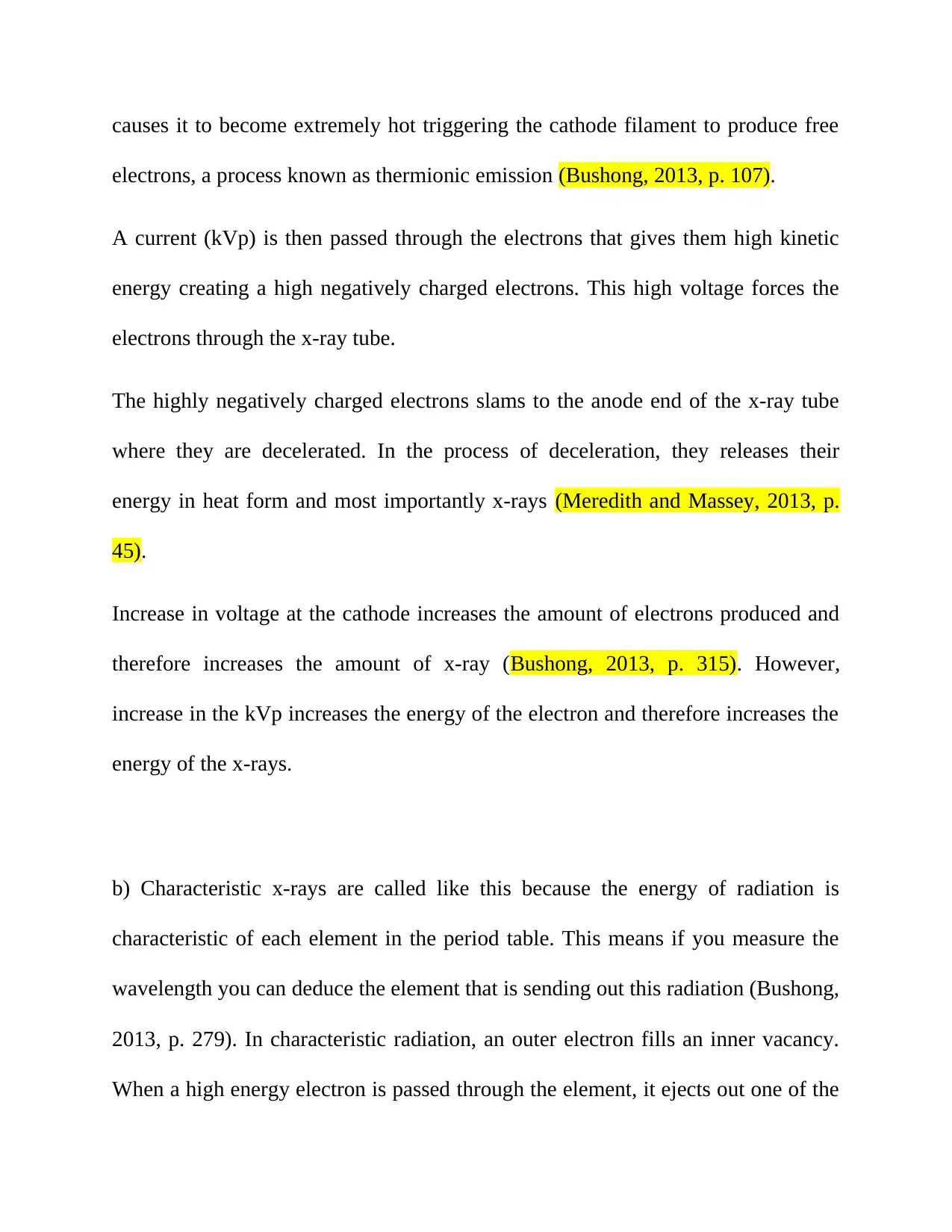
causes it to become extremely hot triggering the cathode filament to produce free
electrons, a process known as thermionic emission (Bushong, 2013, p. 107).
A current (kVp) is then passed through the electrons that gives them high kinetic
energy creating a high negatively charged electrons. This high voltage forces the
electrons through the x-ray tube.
The highly negatively charged electrons slams to the anode end of the x-ray tube
where they are decelerated. In the process of deceleration, they releases their
energy in heat form and most importantly x-rays (Meredith and Massey, 2013, p.
45).
Increase in voltage at the cathode increases the amount of electrons produced and
therefore increases the amount of x-ray (Bushong, 2013, p. 315). However,
increase in the kVp increases the energy of the electron and therefore increases the
energy of the x-rays.
b) Characteristic x-rays are called like this because the energy of radiation is
characteristic of each element in the period table. This means if you measure the
wavelength you can deduce the element that is sending out this radiation (Bushong,
2013, p. 279). In characteristic radiation, an outer electron fills an inner vacancy.
When a high energy electron is passed through the element, it ejects out one of the
electrons, a process known as thermionic emission (Bushong, 2013, p. 107).
A current (kVp) is then passed through the electrons that gives them high kinetic
energy creating a high negatively charged electrons. This high voltage forces the
electrons through the x-ray tube.
The highly negatively charged electrons slams to the anode end of the x-ray tube
where they are decelerated. In the process of deceleration, they releases their
energy in heat form and most importantly x-rays (Meredith and Massey, 2013, p.
45).
Increase in voltage at the cathode increases the amount of electrons produced and
therefore increases the amount of x-ray (Bushong, 2013, p. 315). However,
increase in the kVp increases the energy of the electron and therefore increases the
energy of the x-rays.
b) Characteristic x-rays are called like this because the energy of radiation is
characteristic of each element in the period table. This means if you measure the
wavelength you can deduce the element that is sending out this radiation (Bushong,
2013, p. 279). In characteristic radiation, an outer electron fills an inner vacancy.
When a high energy electron is passed through the element, it ejects out one of the
⊘ This is a preview!⊘
Do you want full access?
Subscribe today to unlock all pages.

Trusted by 1+ million students worldwide
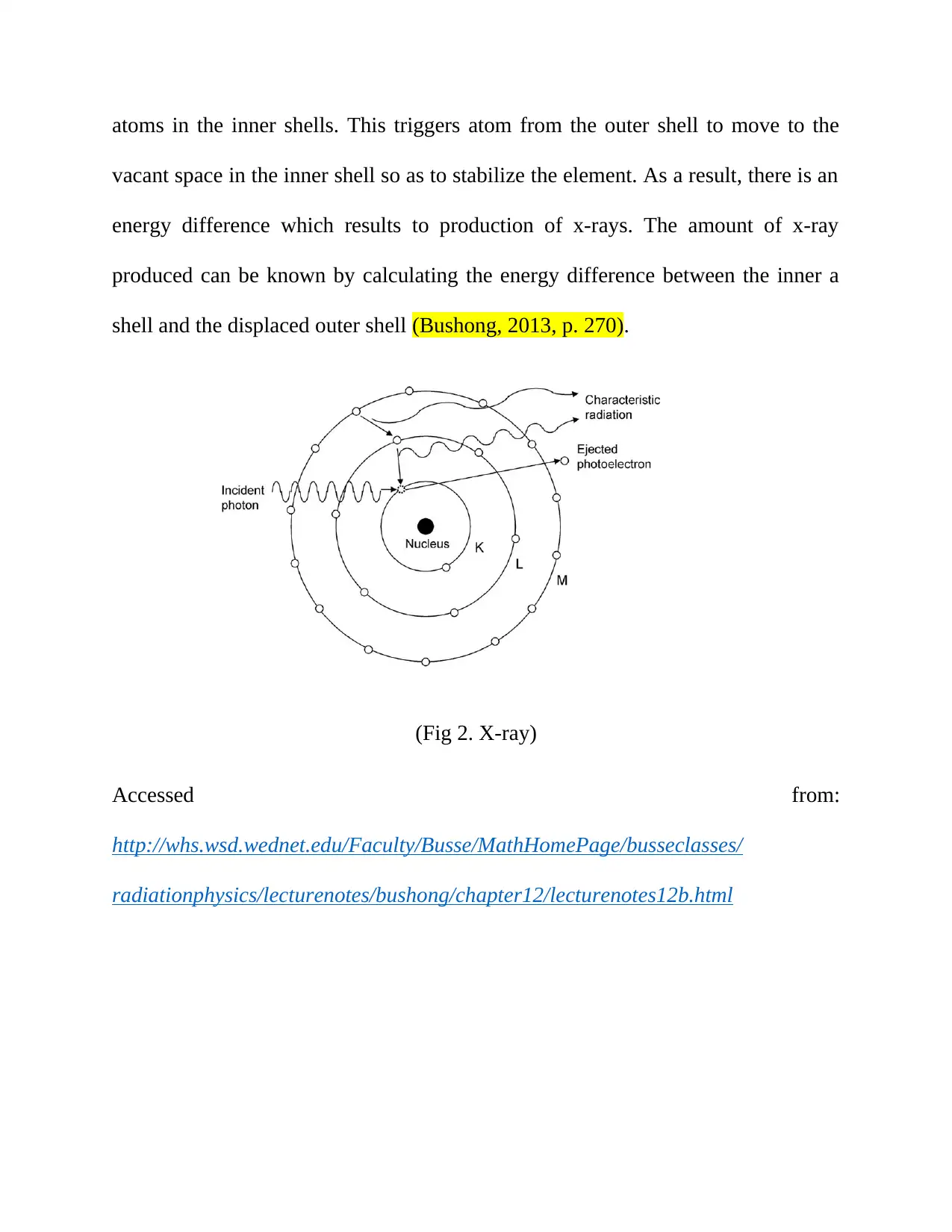
atoms in the inner shells. This triggers atom from the outer shell to move to the
vacant space in the inner shell so as to stabilize the element. As a result, there is an
energy difference which results to production of x-rays. The amount of x-ray
produced can be known by calculating the energy difference between the inner a
shell and the displaced outer shell (Bushong, 2013, p. 270).
(Fig 2. X-ray)
Accessed from:
http://whs.wsd.wednet.edu/Faculty/Busse/MathHomePage/busseclasses/
radiationphysics/lecturenotes/bushong/chapter12/lecturenotes12b.html
vacant space in the inner shell so as to stabilize the element. As a result, there is an
energy difference which results to production of x-rays. The amount of x-ray
produced can be known by calculating the energy difference between the inner a
shell and the displaced outer shell (Bushong, 2013, p. 270).
(Fig 2. X-ray)
Accessed from:
http://whs.wsd.wednet.edu/Faculty/Busse/MathHomePage/busseclasses/
radiationphysics/lecturenotes/bushong/chapter12/lecturenotes12b.html
Paraphrase This Document
Need a fresh take? Get an instant paraphrase of this document with our AI Paraphraser
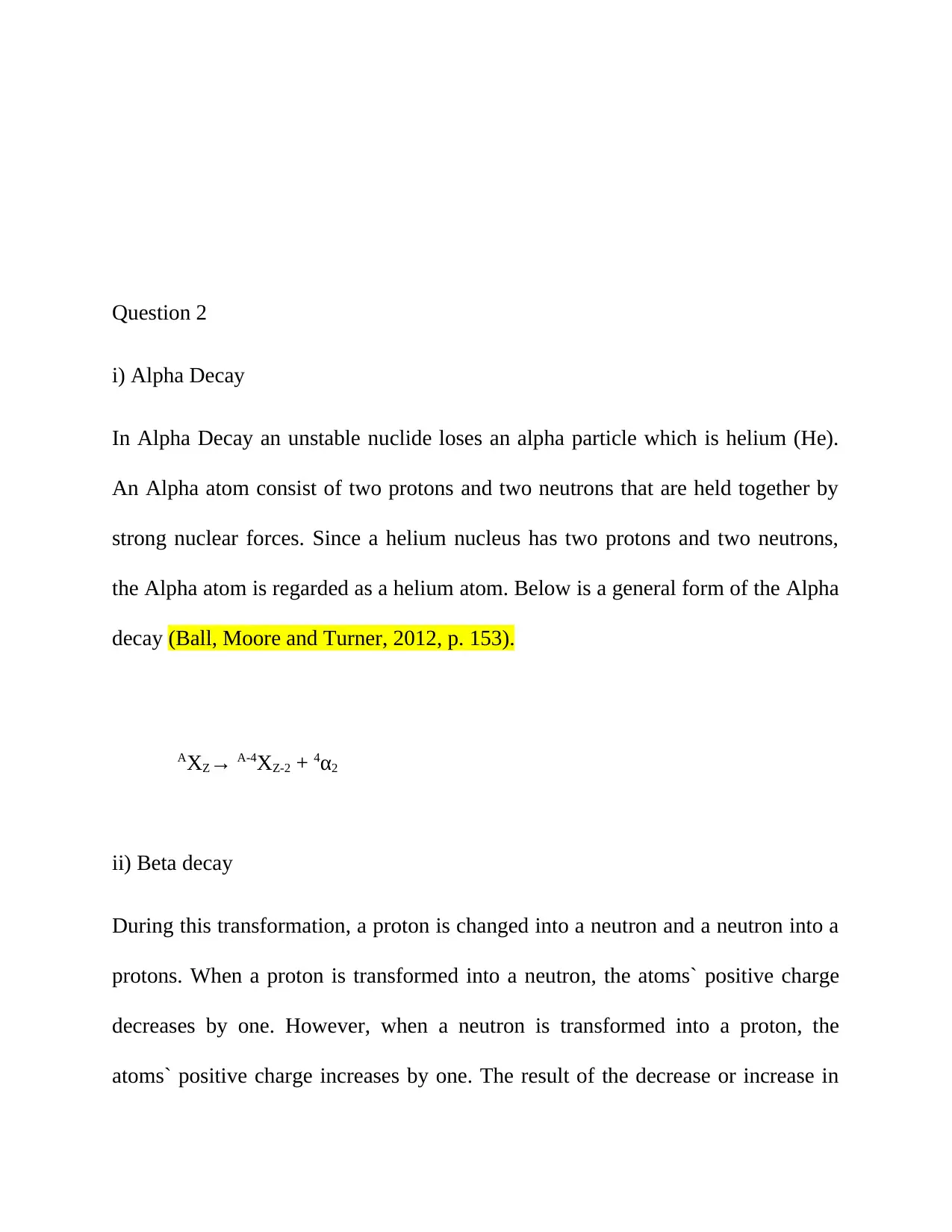
Question 2
i) Alpha Decay
In Alpha Decay an unstable nuclide loses an alpha particle which is helium (He).
An Alpha atom consist of two protons and two neutrons that are held together by
strong nuclear forces. Since a helium nucleus has two protons and two neutrons,
the Alpha atom is regarded as a helium atom. Below is a general form of the Alpha
decay (Ball, Moore and Turner, 2012, p. 153).
AXZ→ A-4XZ-2 + 4α2
ii) Beta decay
During this transformation, a proton is changed into a neutron and a neutron into a
protons. When a proton is transformed into a neutron, the atoms` positive charge
decreases by one. However, when a neutron is transformed into a proton, the
atoms` positive charge increases by one. The result of the decrease or increase in
i) Alpha Decay
In Alpha Decay an unstable nuclide loses an alpha particle which is helium (He).
An Alpha atom consist of two protons and two neutrons that are held together by
strong nuclear forces. Since a helium nucleus has two protons and two neutrons,
the Alpha atom is regarded as a helium atom. Below is a general form of the Alpha
decay (Ball, Moore and Turner, 2012, p. 153).
AXZ→ A-4XZ-2 + 4α2
ii) Beta decay
During this transformation, a proton is changed into a neutron and a neutron into a
protons. When a proton is transformed into a neutron, the atoms` positive charge
decreases by one. However, when a neutron is transformed into a proton, the
atoms` positive charge increases by one. The result of the decrease or increase in
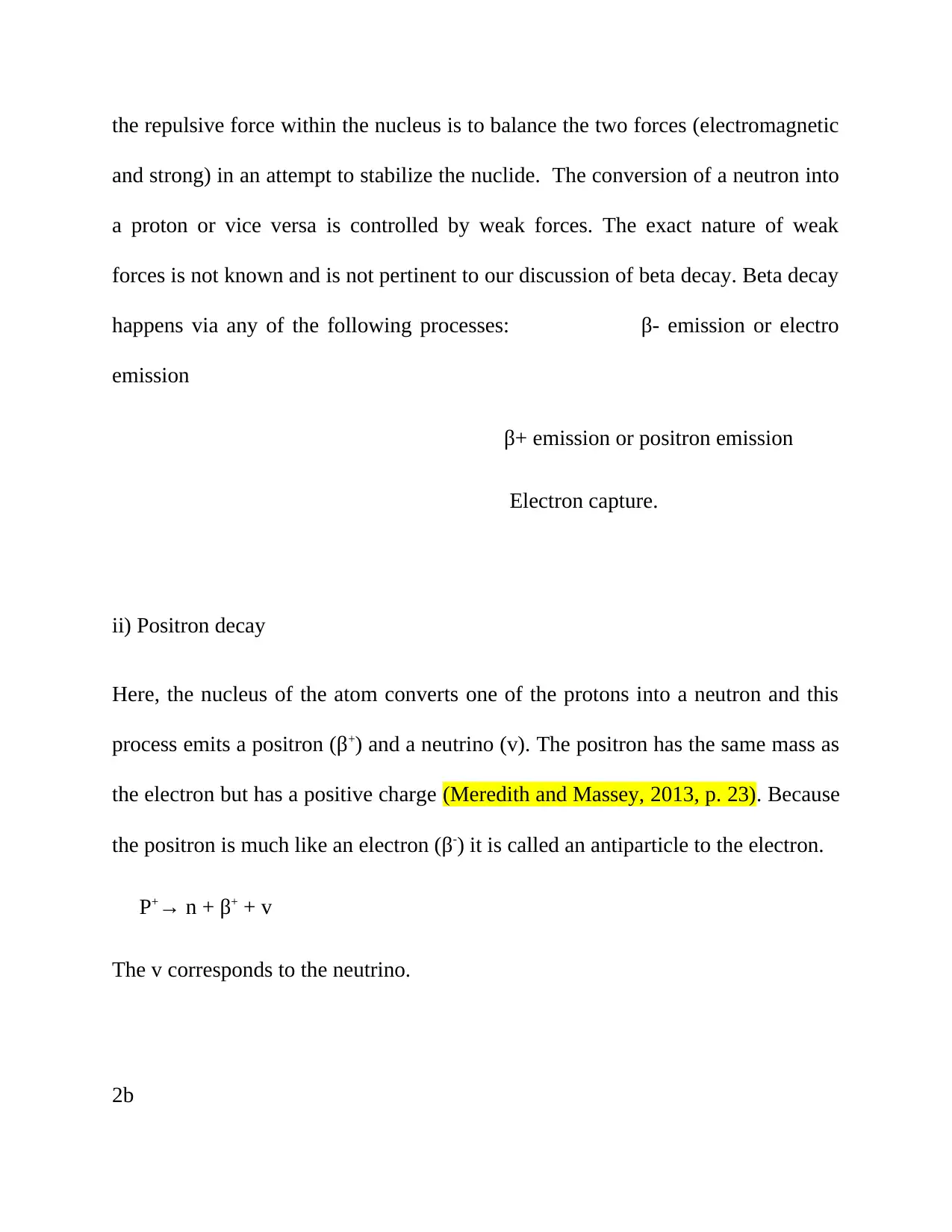
the repulsive force within the nucleus is to balance the two forces (electromagnetic
and strong) in an attempt to stabilize the nuclide. The conversion of a neutron into
a proton or vice versa is controlled by weak forces. The exact nature of weak
forces is not known and is not pertinent to our discussion of beta decay. Beta decay
happens via any of the following processes: β- emission or electro
emission
β+ emission or positron emission
Electron capture.
ii) Positron decay
Here, the nucleus of the atom converts one of the protons into a neutron and this
process emits a positron (β+) and a neutrino (v). The positron has the same mass as
the electron but has a positive charge (Meredith and Massey, 2013, p. 23). Because
the positron is much like an electron (β-) it is called an antiparticle to the electron.
P+→ n + β+ + v
The v corresponds to the neutrino.
2b
and strong) in an attempt to stabilize the nuclide. The conversion of a neutron into
a proton or vice versa is controlled by weak forces. The exact nature of weak
forces is not known and is not pertinent to our discussion of beta decay. Beta decay
happens via any of the following processes: β- emission or electro
emission
β+ emission or positron emission
Electron capture.
ii) Positron decay
Here, the nucleus of the atom converts one of the protons into a neutron and this
process emits a positron (β+) and a neutrino (v). The positron has the same mass as
the electron but has a positive charge (Meredith and Massey, 2013, p. 23). Because
the positron is much like an electron (β-) it is called an antiparticle to the electron.
P+→ n + β+ + v
The v corresponds to the neutrino.
2b
⊘ This is a preview!⊘
Do you want full access?
Subscribe today to unlock all pages.

Trusted by 1+ million students worldwide
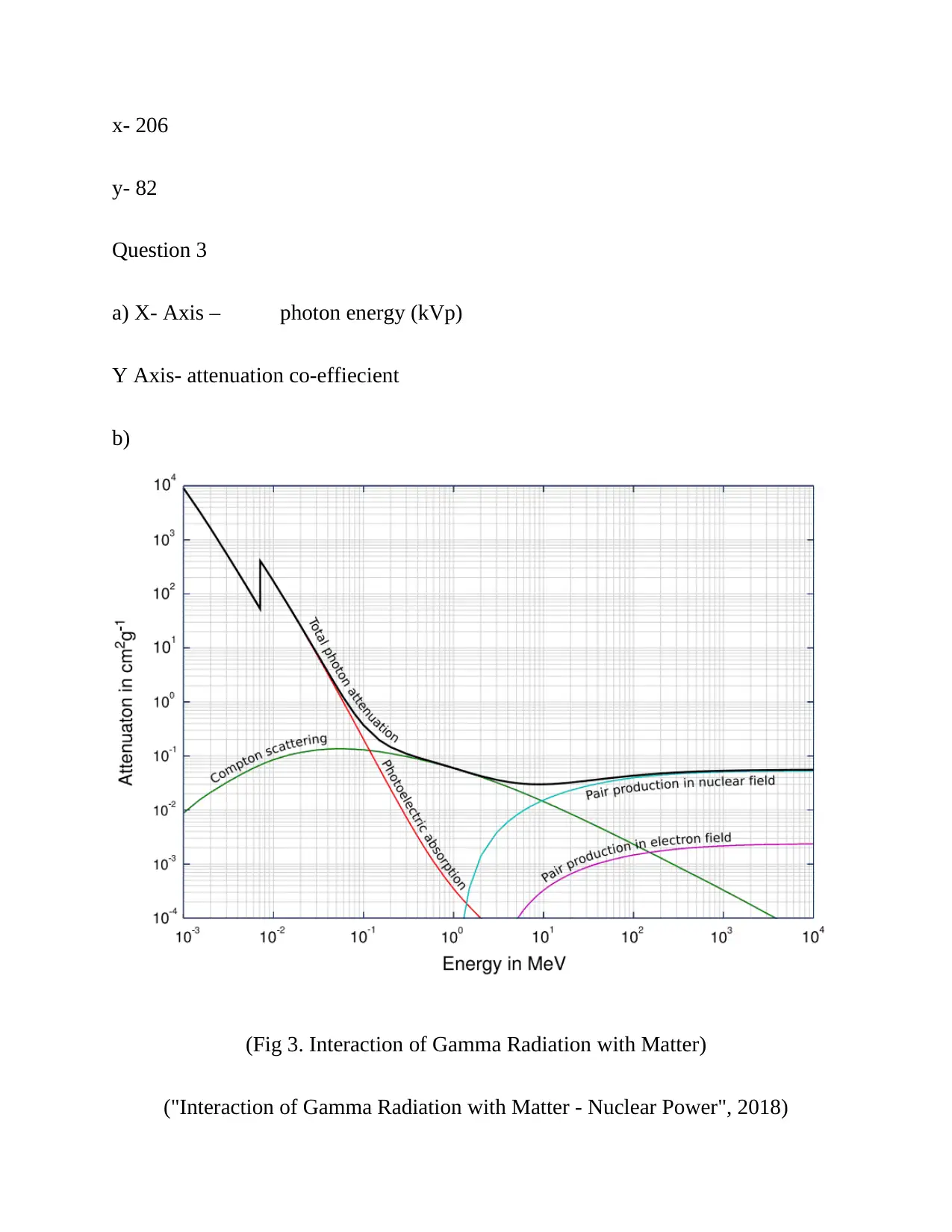
x- 206
y- 82
Question 3
a) X- Axis – photon energy (kVp)
Y Axis- attenuation co-effiecient
b)
(Fig 3. Interaction of Gamma Radiation with Matter)
("Interaction of Gamma Radiation with Matter - Nuclear Power", 2018)
y- 82
Question 3
a) X- Axis – photon energy (kVp)
Y Axis- attenuation co-effiecient
b)
(Fig 3. Interaction of Gamma Radiation with Matter)
("Interaction of Gamma Radiation with Matter - Nuclear Power", 2018)
Paraphrase This Document
Need a fresh take? Get an instant paraphrase of this document with our AI Paraphraser
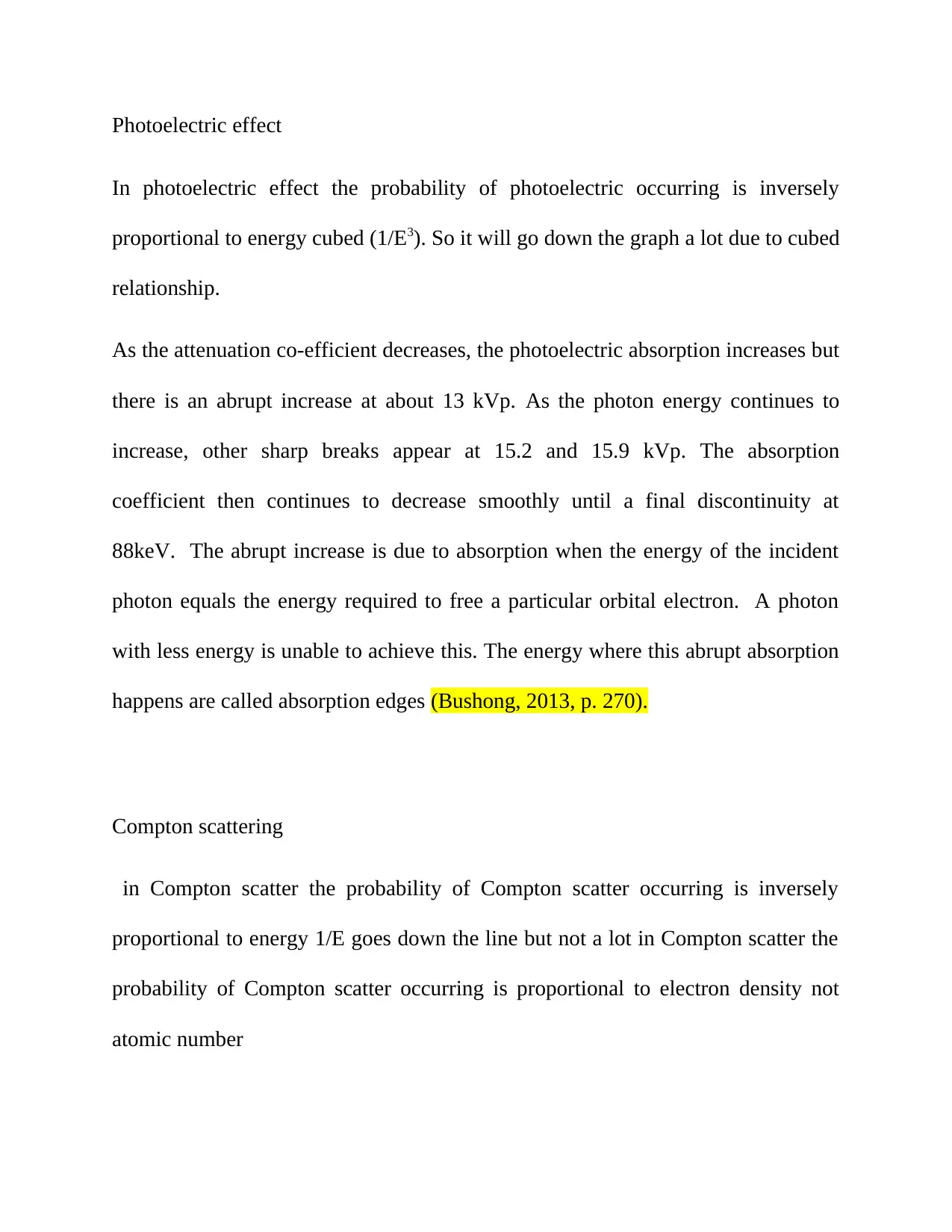
Photoelectric effect
In photoelectric effect the probability of photoelectric occurring is inversely
proportional to energy cubed (1/E3). So it will go down the graph a lot due to cubed
relationship.
As the attenuation co-efficient decreases, the photoelectric absorption increases but
there is an abrupt increase at about 13 kVp. As the photon energy continues to
increase, other sharp breaks appear at 15.2 and 15.9 kVp. The absorption
coefficient then continues to decrease smoothly until a final discontinuity at
88keV. The abrupt increase is due to absorption when the energy of the incident
photon equals the energy required to free a particular orbital electron. A photon
with less energy is unable to achieve this. The energy where this abrupt absorption
happens are called absorption edges (Bushong, 2013, p. 270).
Compton scattering
in Compton scatter the probability of Compton scatter occurring is inversely
proportional to energy 1/E goes down the line but not a lot in Compton scatter the
probability of Compton scatter occurring is proportional to electron density not
atomic number
In photoelectric effect the probability of photoelectric occurring is inversely
proportional to energy cubed (1/E3). So it will go down the graph a lot due to cubed
relationship.
As the attenuation co-efficient decreases, the photoelectric absorption increases but
there is an abrupt increase at about 13 kVp. As the photon energy continues to
increase, other sharp breaks appear at 15.2 and 15.9 kVp. The absorption
coefficient then continues to decrease smoothly until a final discontinuity at
88keV. The abrupt increase is due to absorption when the energy of the incident
photon equals the energy required to free a particular orbital electron. A photon
with less energy is unable to achieve this. The energy where this abrupt absorption
happens are called absorption edges (Bushong, 2013, p. 270).
Compton scattering
in Compton scatter the probability of Compton scatter occurring is inversely
proportional to energy 1/E goes down the line but not a lot in Compton scatter the
probability of Compton scatter occurring is proportional to electron density not
atomic number
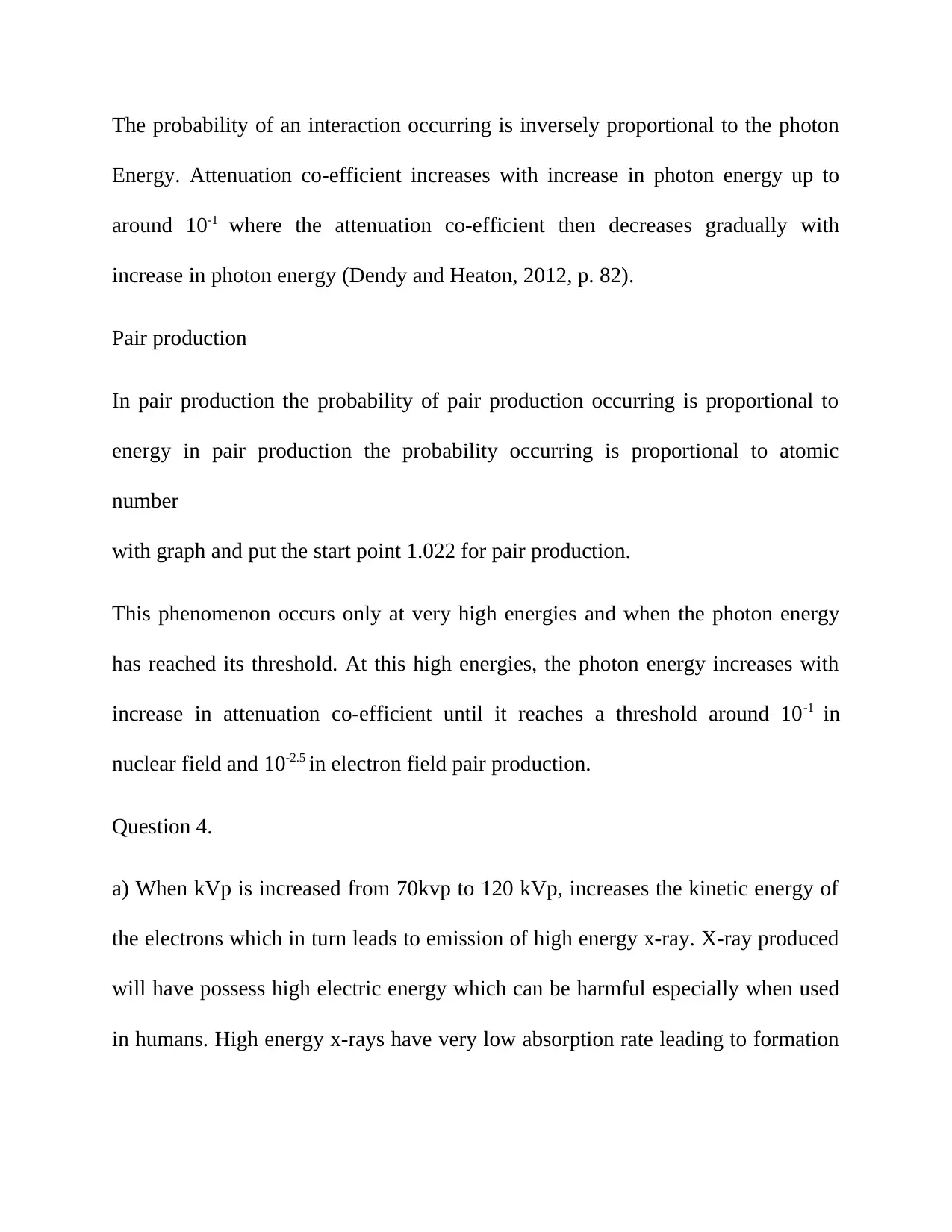
The probability of an interaction occurring is inversely proportional to the photon
Energy. Attenuation co-efficient increases with increase in photon energy up to
around 10-1 where the attenuation co-efficient then decreases gradually with
increase in photon energy (Dendy and Heaton, 2012, p. 82).
Pair production
In pair production the probability of pair production occurring is proportional to
energy in pair production the probability occurring is proportional to atomic
number
with graph and put the start point 1.022 for pair production.
This phenomenon occurs only at very high energies and when the photon energy
has reached its threshold. At this high energies, the photon energy increases with
increase in attenuation co-efficient until it reaches a threshold around 10-1 in
nuclear field and 10-2.5 in electron field pair production.
Question 4.
a) When kVp is increased from 70kvp to 120 kVp, increases the kinetic energy of
the electrons which in turn leads to emission of high energy x-ray. X-ray produced
will have possess high electric energy which can be harmful especially when used
in humans. High energy x-rays have very low absorption rate leading to formation
Energy. Attenuation co-efficient increases with increase in photon energy up to
around 10-1 where the attenuation co-efficient then decreases gradually with
increase in photon energy (Dendy and Heaton, 2012, p. 82).
Pair production
In pair production the probability of pair production occurring is proportional to
energy in pair production the probability occurring is proportional to atomic
number
with graph and put the start point 1.022 for pair production.
This phenomenon occurs only at very high energies and when the photon energy
has reached its threshold. At this high energies, the photon energy increases with
increase in attenuation co-efficient until it reaches a threshold around 10-1 in
nuclear field and 10-2.5 in electron field pair production.
Question 4.
a) When kVp is increased from 70kvp to 120 kVp, increases the kinetic energy of
the electrons which in turn leads to emission of high energy x-ray. X-ray produced
will have possess high electric energy which can be harmful especially when used
in humans. High energy x-rays have very low absorption rate leading to formation
⊘ This is a preview!⊘
Do you want full access?
Subscribe today to unlock all pages.

Trusted by 1+ million students worldwide
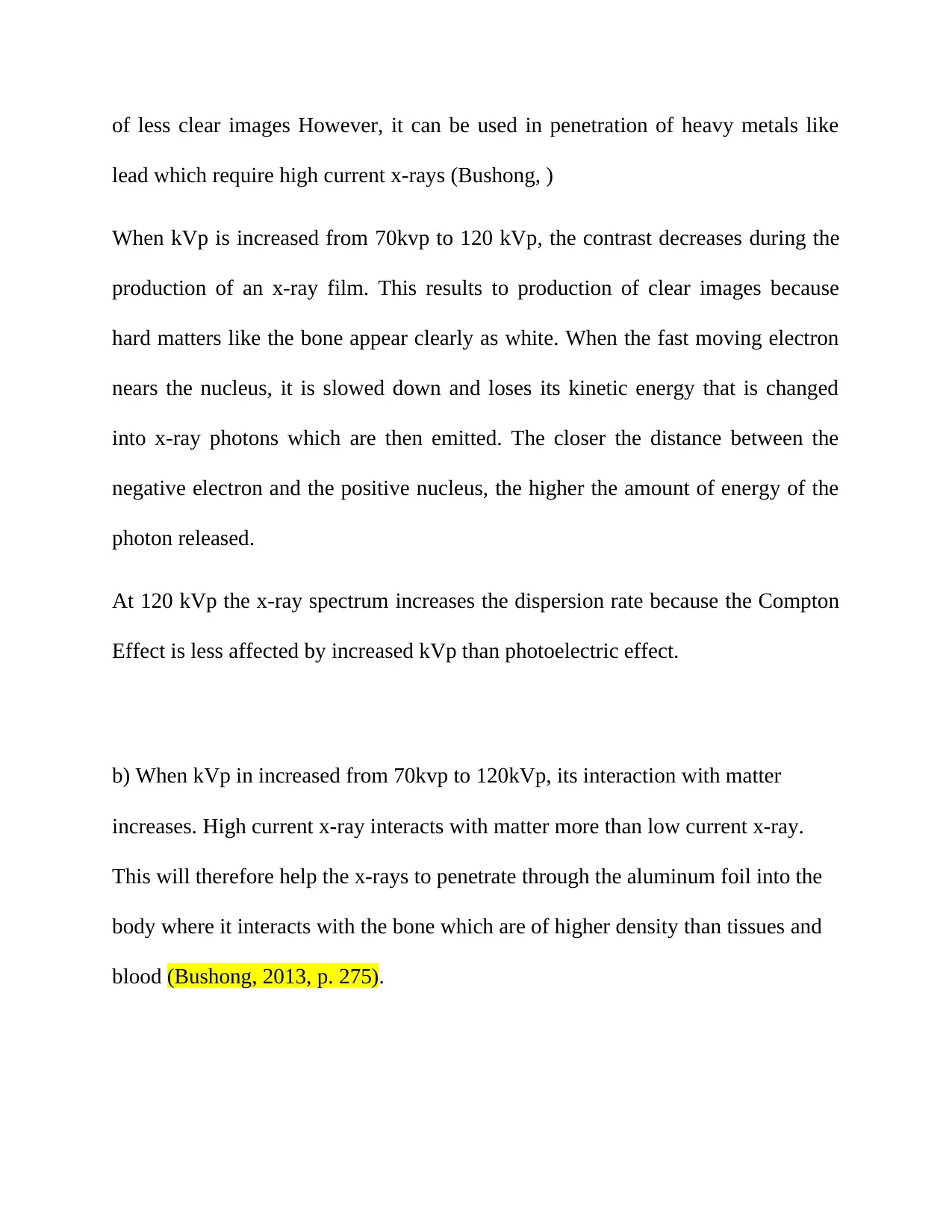
of less clear images However, it can be used in penetration of heavy metals like
lead which require high current x-rays (Bushong, )
When kVp is increased from 70kvp to 120 kVp, the contrast decreases during the
production of an x-ray film. This results to production of clear images because
hard matters like the bone appear clearly as white. When the fast moving electron
nears the nucleus, it is slowed down and loses its kinetic energy that is changed
into x-ray photons which are then emitted. The closer the distance between the
negative electron and the positive nucleus, the higher the amount of energy of the
photon released.
At 120 kVp the x-ray spectrum increases the dispersion rate because the Compton
Effect is less affected by increased kVp than photoelectric effect.
b) When kVp in increased from 70kvp to 120kVp, its interaction with matter
increases. High current x-ray interacts with matter more than low current x-ray.
This will therefore help the x-rays to penetrate through the aluminum foil into the
body where it interacts with the bone which are of higher density than tissues and
blood (Bushong, 2013, p. 275).
lead which require high current x-rays (Bushong, )
When kVp is increased from 70kvp to 120 kVp, the contrast decreases during the
production of an x-ray film. This results to production of clear images because
hard matters like the bone appear clearly as white. When the fast moving electron
nears the nucleus, it is slowed down and loses its kinetic energy that is changed
into x-ray photons which are then emitted. The closer the distance between the
negative electron and the positive nucleus, the higher the amount of energy of the
photon released.
At 120 kVp the x-ray spectrum increases the dispersion rate because the Compton
Effect is less affected by increased kVp than photoelectric effect.
b) When kVp in increased from 70kvp to 120kVp, its interaction with matter
increases. High current x-ray interacts with matter more than low current x-ray.
This will therefore help the x-rays to penetrate through the aluminum foil into the
body where it interacts with the bone which are of higher density than tissues and
blood (Bushong, 2013, p. 275).
Paraphrase This Document
Need a fresh take? Get an instant paraphrase of this document with our AI Paraphraser
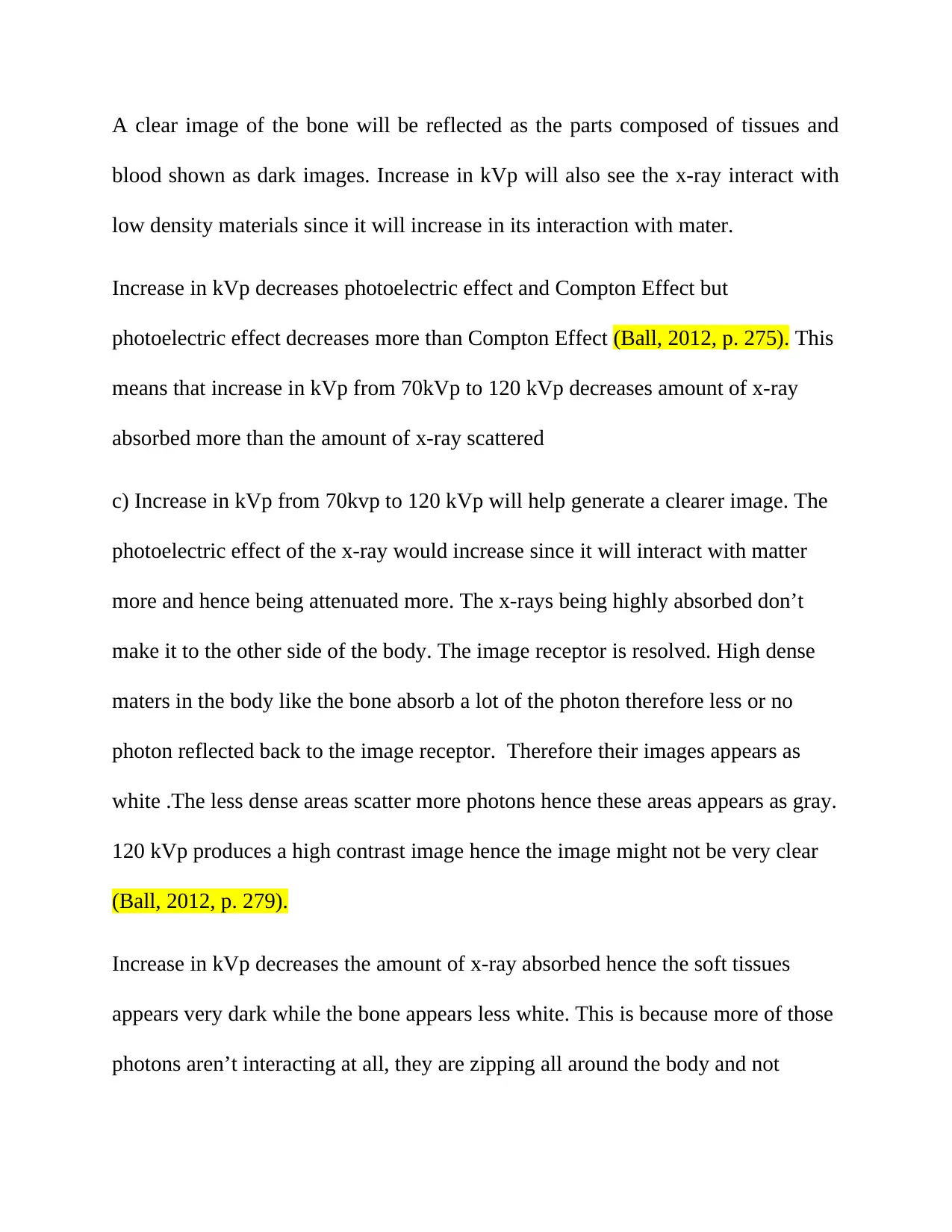
A clear image of the bone will be reflected as the parts composed of tissues and
blood shown as dark images. Increase in kVp will also see the x-ray interact with
low density materials since it will increase in its interaction with mater.
Increase in kVp decreases photoelectric effect and Compton Effect but
photoelectric effect decreases more than Compton Effect (Ball, 2012, p. 275). This
means that increase in kVp from 70kVp to 120 kVp decreases amount of x-ray
absorbed more than the amount of x-ray scattered
c) Increase in kVp from 70kvp to 120 kVp will help generate a clearer image. The
photoelectric effect of the x-ray would increase since it will interact with matter
more and hence being attenuated more. The x-rays being highly absorbed don’t
make it to the other side of the body. The image receptor is resolved. High dense
maters in the body like the bone absorb a lot of the photon therefore less or no
photon reflected back to the image receptor. Therefore their images appears as
white .The less dense areas scatter more photons hence these areas appears as gray.
120 kVp produces a high contrast image hence the image might not be very clear
(Ball, 2012, p. 279).
Increase in kVp decreases the amount of x-ray absorbed hence the soft tissues
appears very dark while the bone appears less white. This is because more of those
photons aren’t interacting at all, they are zipping all around the body and not
blood shown as dark images. Increase in kVp will also see the x-ray interact with
low density materials since it will increase in its interaction with mater.
Increase in kVp decreases photoelectric effect and Compton Effect but
photoelectric effect decreases more than Compton Effect (Ball, 2012, p. 275). This
means that increase in kVp from 70kVp to 120 kVp decreases amount of x-ray
absorbed more than the amount of x-ray scattered
c) Increase in kVp from 70kvp to 120 kVp will help generate a clearer image. The
photoelectric effect of the x-ray would increase since it will interact with matter
more and hence being attenuated more. The x-rays being highly absorbed don’t
make it to the other side of the body. The image receptor is resolved. High dense
maters in the body like the bone absorb a lot of the photon therefore less or no
photon reflected back to the image receptor. Therefore their images appears as
white .The less dense areas scatter more photons hence these areas appears as gray.
120 kVp produces a high contrast image hence the image might not be very clear
(Ball, 2012, p. 279).
Increase in kVp decreases the amount of x-ray absorbed hence the soft tissues
appears very dark while the bone appears less white. This is because more of those
photons aren’t interacting at all, they are zipping all around the body and not
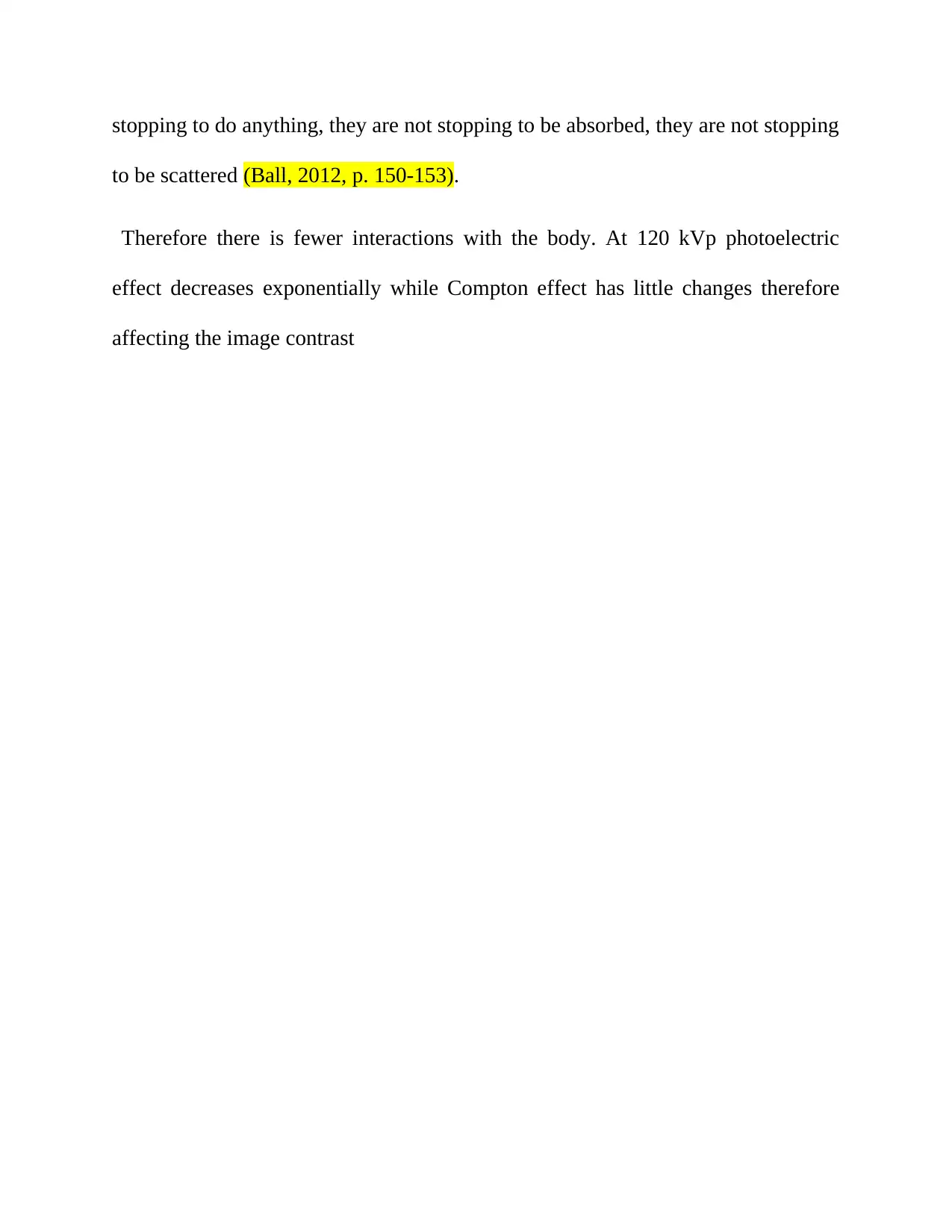
stopping to do anything, they are not stopping to be absorbed, they are not stopping
to be scattered (Ball, 2012, p. 150-153).
Therefore there is fewer interactions with the body. At 120 kVp photoelectric
effect decreases exponentially while Compton effect has little changes therefore
affecting the image contrast
to be scattered (Ball, 2012, p. 150-153).
Therefore there is fewer interactions with the body. At 120 kVp photoelectric
effect decreases exponentially while Compton effect has little changes therefore
affecting the image contrast
⊘ This is a preview!⊘
Do you want full access?
Subscribe today to unlock all pages.

Trusted by 1+ million students worldwide
1 out of 14
Related Documents
Your All-in-One AI-Powered Toolkit for Academic Success.
+13062052269
info@desklib.com
Available 24*7 on WhatsApp / Email
![[object Object]](/_next/static/media/star-bottom.7253800d.svg)
Unlock your academic potential
Copyright © 2020–2025 A2Z Services. All Rights Reserved. Developed and managed by ZUCOL.




